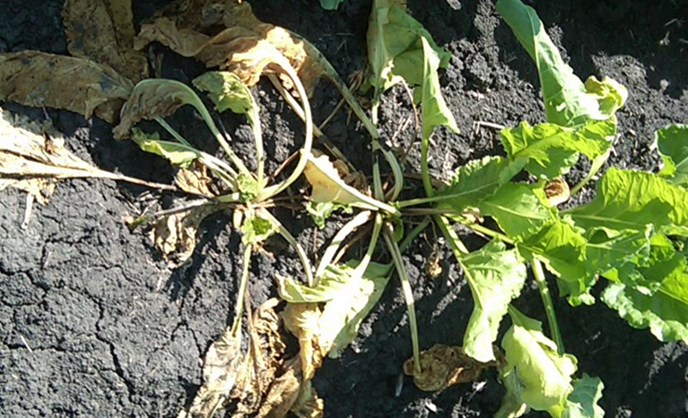636 - On Time In-Season Treatments For Successful Control
Probably the biggest component for the success of any pesticide application is proper timing. In-season field scouting and historical knowledge of pest pressures affecting a particular field are imperative to getting the timing right.
Treat weeds when they are very small, as herbicide control will be compromised if left to grow too large and most times increasing rates won’t necessarily improve control. If sugarbeet root maggot insecticide applications occur too late, the flies have already laid their eggs and the resulting larvae will feed on roots. Timing rhizoctonia fungicide treatments protect the root from yield robbing infections.
Below are some in-season best management practices with links to additional more detailed resources
As always, contact your Agriculturist for more information.
Weed Control
ACSC Weed Control Gold Standard Resources
2024 Sugarbeet Weed Management Recommendations
- Kochia considerations - Kochia is the earliest emerging problematic weed and requires early season control measures. Treating small, “dime-sized” kochia is paramount to increasing control success.
- Preplant incorporated (PPI) or Preemerge (PRE) using soil applied herbicides are critical for control.
- A burndown Gramoxone application can be used if sugarbeets are not emerged.
- Spin-Aid is not a rescue treatment but needs to be part of the planned treatment program.
- Emerged kochia needs to be treated when it is very small, “dime”-sized for success.
- Rates are determined by size of sugarbeets.
- Tallow Amine containing adjuvants
- Dr. Peters conducted a greenhouse study this spring showing the use of a tallow amine containing adjuvant (Level Best Pro) increased kochia control.
- Known tallow amine containing products: Level Best Pro, Last Chance Pro, Full Load, GlyLoad
- Further studies are needed to evaluate control of other weed species.

- Waterhemp considerations - Waterhemp emerges a bit later than kochia, however it continues to emerge throughout the growing season.
- Common Lambsquarters - Emerges about the same time as common ragweed.
- Make sure to use a full rate of PowerMax3 and NIS adjuvant.
- Plan on 2 treatments for control.
- At times common lambsquarters can be difficult to control due to a very waxy leaf cuticle.
- Adding Spin-Aid can help increase control.
- Common Ragweed - Common ragweed is an early season weed, emerging just after kochia.
- Use Stinger HL and time treatments when ragweed is 2” or less in size.
- Plan for 2 treatments for control.
- There are areas where common ragweed is increasingly tough to control.
- Tom Peters’ research has indicated Stinger HL with the addition of Spin-Aid improved control.
Sugarbeet Root Maggot (SBRM)
ACSC Insect Control Gold Standards Resources
2024 Sugarbeet Root Maggot Management Recommendations
- Use well-timed, effective POST insecticides to knock down the SBRM fly population. This reduces the number of eggs that are laid and the resulting maggot population that the At-Plant insecticide must control.
- Thimet @ 7 lbs./acre applied 5-15 days prior to peak fly activity.
- Post liquid insecticide applications should be made as fly populations build at increments of 70-100 flies/stake.
- Post liquid insecticides include Mustang Maxx, Asana XL, or state registered chlorpyrifos products.
- Registered chlorpyrifos products labeled for use on sugarbeets. Only chlorpyrifos products that are labeled for use in their respective state can be used.
- 2024 Fly Stake Counts
- SBRM Degree Days

Rhizoctonia
ACSC Disease Control Gold Standards Resources
2024 Rhizoctonia Management Recommendations
- All seed has a Rhizoctonia fungicide seed treatment on it and you may have also applied an at-plant treatment
- Depending on rhizoctonia pressure based on prior field history, crop rotation, previous crop, and varietal tolerance, a post fungicide application may be necessary.
- Time Post Rhizoctonia fungicide treatments at the 4 – 8 leaf sugarbeet stage
- Rhizoctonia fungicide tank mixing
- Excalia Rhizoctonia Fungicide
- No concerns of Excalia causing injury when added to complex tank-mixes.
- No concerns tank mixing Excalia with only Mustang Maxx or only liquid Chlorpyrifos insecticide.
- Quadris Rhizoctonia Fungicide (azoxystrobin)
- Do not tank-mix Quadris with oil based conventional pesticides/adjuvants.
- Time application 3 days before & after conventional pesticide application.
- No concerns with tank mixing Quadris with PowerMAX3 & Stinger HL.
- No concerns tank mixing Quadris with only Mustang Maxx insecticide.
- Do not tank mix with liquid Chlorpyrifos insecticide.
- Excalia Rhizoctonia Fungicide

Complex Tank Mixtures
See link for general recommendations on pesticide tank mixes that are: safe, of some concern, heightened concern, or are not recommended. These were developed in coordination with Dr. Tom Peters based on his Complex Tank Mix Research.
